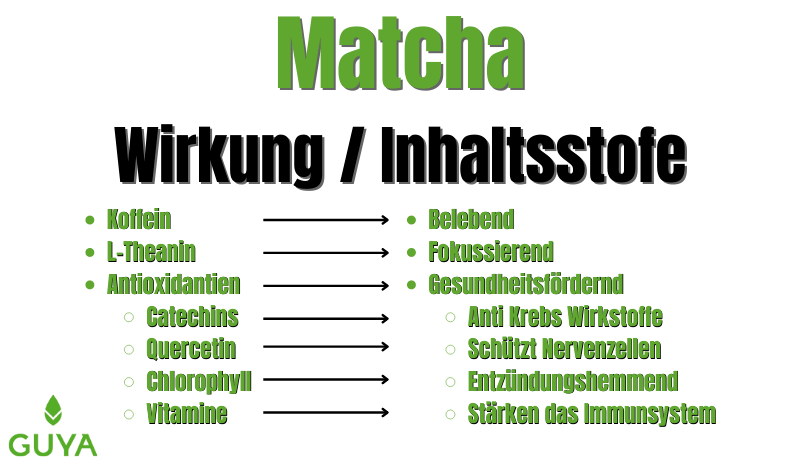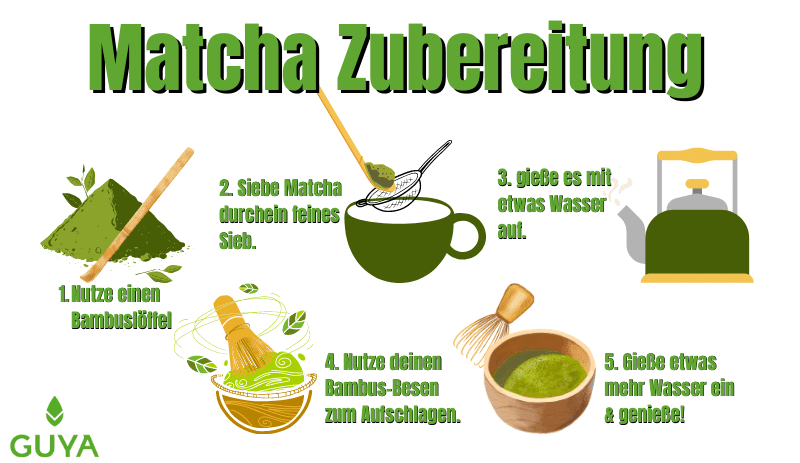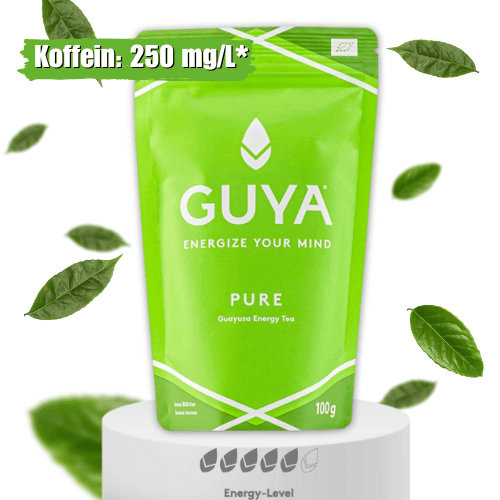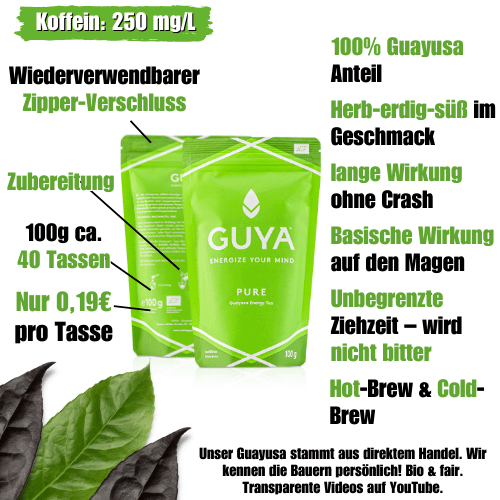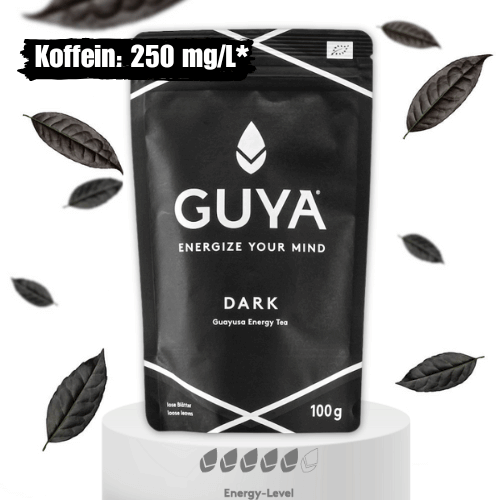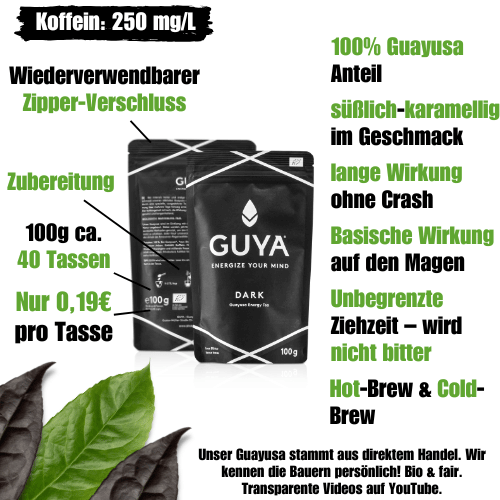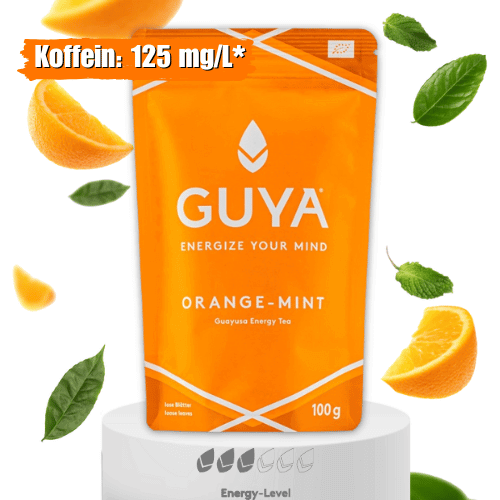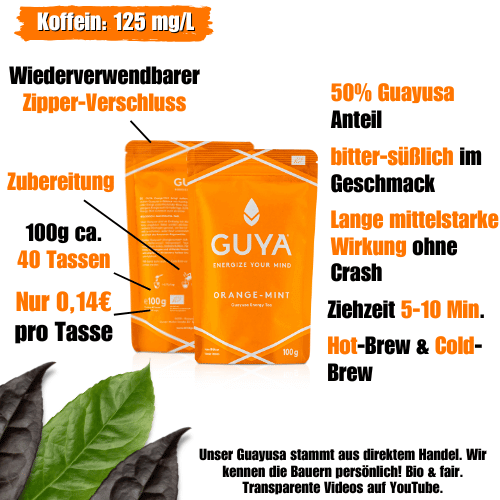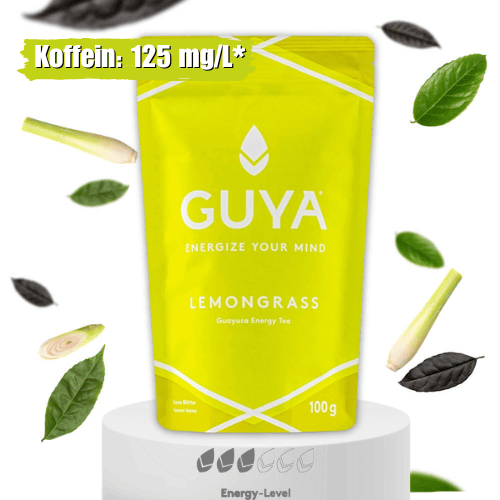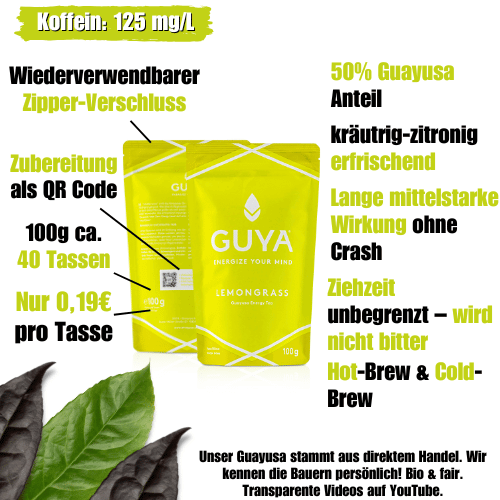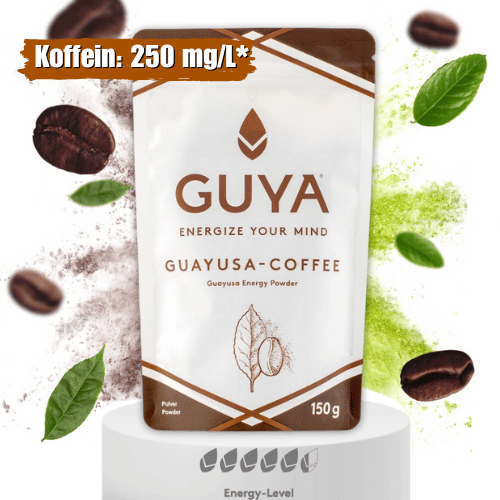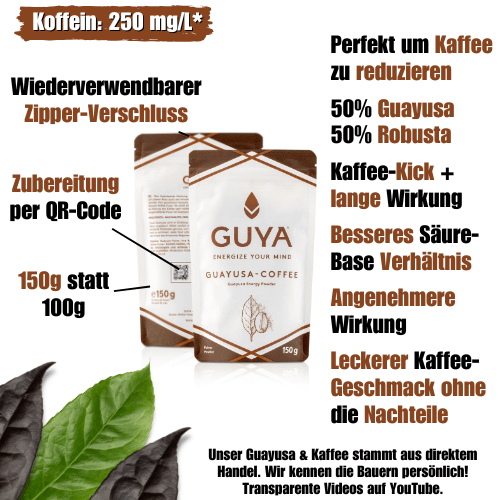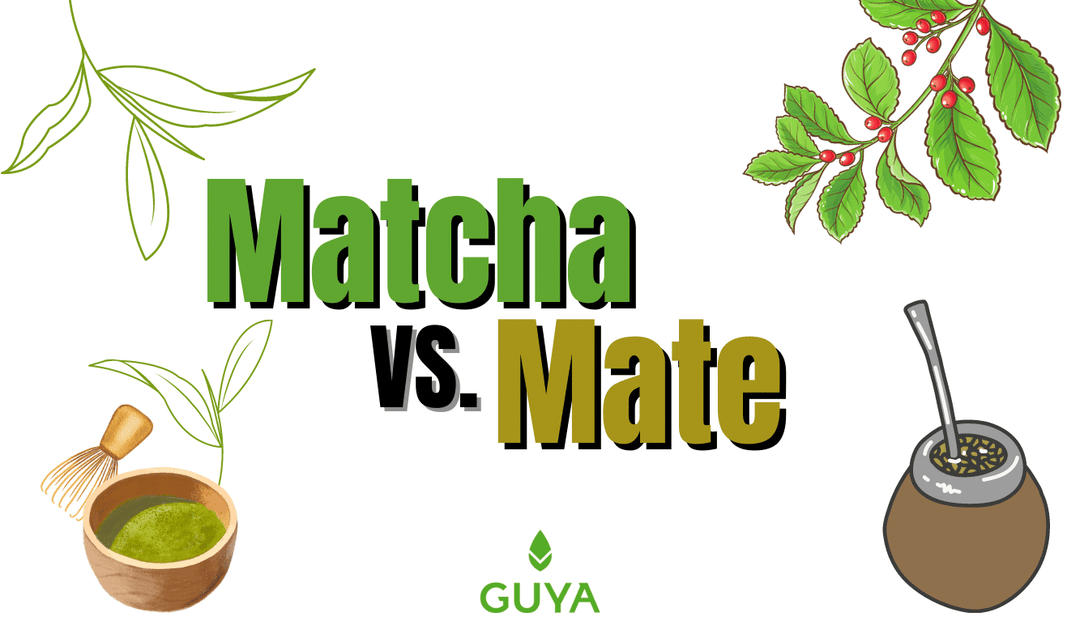Matcha tea - Matcha plant, effect, taste & caffeine

Introduction
Matcha tea is a mystery for many, in this article we would like to educate about the Matcha plant, their effect, taste, ingredients such as caffeine and much more. This article is intended as an extensive overview of Matcha. Accordingly, we will link further contributions to you in more detail on specific topics on Matcha.
Contents
- What is Matcha tea?
- Matcha tea ingredients and active ingredients
- Matcha effect
- Matcha taste
- Matcha preparation
-
Matcha vs
- Coffee,
- Mate,
- Tea,
- Guayusa tea
- Is Matcha tea healthy?
- Conclusion
1. What is Matcha tea?
Matcha tea is strictly accepted Green tea However, treated very specifically both before and after the harvest. The word Matcha means "ground green tea". In the following, we explain exactly how the Matcha plant becomes the Matcha plant from the green tea plant.
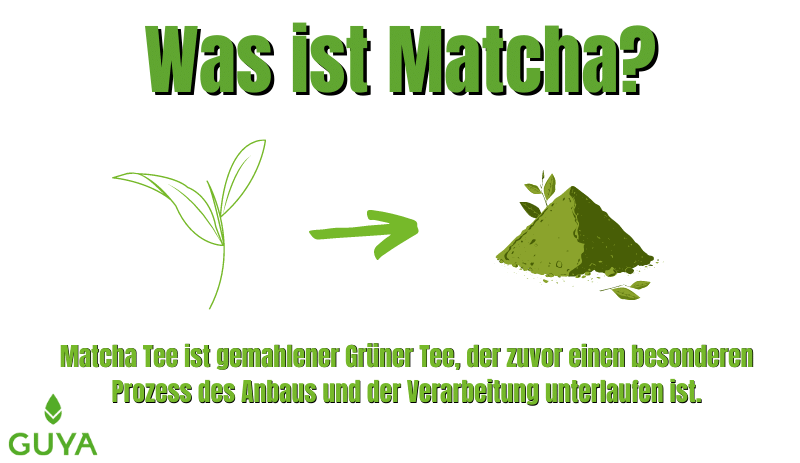
1.1. The Matcha plant
The Matcha plant is created by a special type of cultivation from the green tea plant. A few weeks before the harvest, the leaves of the tea plant Camellia sinensis prepared for the harvest of Matcha leaves. More on that!
1.2. Origin & cultivation of Matcha tea
The way we drink Matcha tea these days we owe the love of the Japanese to green tea! Even if the Chinese were the first to grind green tea, the technology for the Matcha tea drunk today does Japan.
Before the leaves of the tea plant Camellia sinensis are harvested, they must have been shaded for several weeks. This shading protects the leaves from excessive sunlight and leaves less bitter substances to produce. In addition, the leaves become thinner, greener, larger and form more amino acids, which then for the special, so -called, Umami taste are responsible.
Only green tea plants, which were treated in this way before harvesting, are harvested in Japan as Matcha plants.
This pretreatment plays a major role for the Matcha taste! Matcha teas from China, Vietnam, Indonesia or Thailand are often not shaded. A normal green tea harvest is used and simply powdered. The result is a very bitter and not full green fake matcha.

1.3. Matcha processing
After the harvest, the strict processing process of the Matcha leaves begins, because no leaf trunks and not all leaves are later processed into Matcha.
The freshly harvested leaves are protected from a withered with water vapor and then dried with hot air.
Now the greenest and youngest leaves are selected manually in order to be separated from their leaf. The resulting high quality tea is called Tencha and is the basic material used in Japan for Matcha.
Tencha is then ground in stone mills. It takes about an hour to produce high -quality Matcha.
The quality of Matcha can be recognized excellently and easily based on the color, more about the individual Quality levels in the linked article.
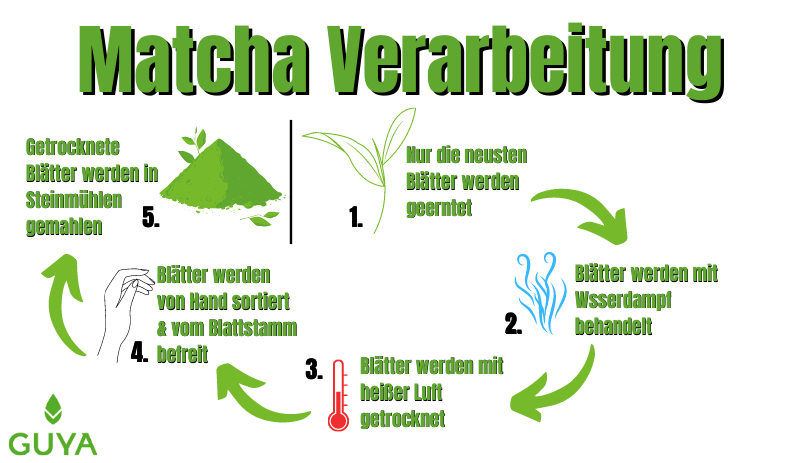
2. Matcha tea ingredients and active ingredients
The Matcha taste differs from normal green tea. The cultivation and processing process is responsible, which in turn is too easy for others ingredients, or the percentage distribution of this, leads.
The best known ingredients are:
- caffeine
- L-theanin
-
Antioxidants
- Catechins
- Rutin
- Quercetin
- Chlorophyll
- Vitamins
3. Matcha effect
Matcha has the great advantage that the tea is not only poured in, but is drunk. For this reason, water -soluble substances such as vitamins cannot be absorbed.
Compared to a bag green tea, the effect of Matcha naturally differs. To a high quality tencha, but not as strong.
In general, the Matcha effect Both stimulating, keep alive, invigorating and relaxing. The Matcha caffeine is highly represented by the cultivation and picking out the youngest leaves compared to green tea. Whereby a Matcha too light Heart racing, shakiness and can lead to leap.
In our articles for Matcha tea effect and the ingredients Let's go into it much more detail.
4. Matcha taste
The taste of Matcha should by no means be strong. A slightly bitter note is normal. Above all, the Umami already mentioned should be in the Matcha taste, especially others.
Umami means "Essence of delicacy“And is often described in Japan as a spicy, meaty and generally intensive taste. Others describe it as fishing, algig, marine and fleshy.
Umami is not a trend word, but is officially one of the 5 Salzig, bitter, sweet, sour and umami! Accordingly, we humans have Umami receptors on our tongue. A detailed description with a diagram can be found in our contribution to the Matcha's taste.
5. Matcha preparation
Like so much in Japan, the preparation of Matcha is a kind of ceremony, or at least a lot of value is placed on individual steps. This should be able to develop the optimal Matcha taste and the general sensory experience. You can find our more detailed article here at Matcha preparation.
6. Matcha vs
As Guayusa We are often asked about the comparison with Matcha, coffee, mate and Co. We would therefore like to give you a brief overview at this point. You will also find more detailed comparisons in our individual items, which we will link you.
6.1. Matcha vs coffee
The first obvious difference is that the beans of the coffee fruit are used for a coffee. These are roasted and, or ground as a "green coffee".
Matcha, on the other hand, is a ground green tea, which was previously grown and processed in a very special way.
The two caffeinated drinks also differ in the effect. Green tea works due to its high number of antioxidants and the rare active ingredient L-theanine, which also in Guayusa You can find more pleasant on the body.
The well-known caffeine crash from coffee is perceived as less strong at Matcha. In addition, the Matcha effect is described much more than a kind of "tea drunk", which can be felt in a head-heavy and less body-littered manner.
Our detailed comparison "Matcha VS coffee - Matcha or coffee?“ It goes even more precisely on the effect, ingredients and other aspects.
6.2. Matcha vs Mate
Yerba Mate Tea and Matcha are often confused by some. However, the difference is enormous! Mate tea comes from South America, in fact Peru, Argentina, Brazil and Paraguay. Matcha tea comes from Japan.
There are two different plants: Ilex paraguaria is the official name for Mate and Camellia sinensis is the tea plant.
The leaves are not drunk at Mate, but either traditionally filtered with the help of a straw or filtered by a normal tea strainer.
Mate and Matcha also differ in the effect. The mate plant does not have a L-theanine, which means that no relaxed focus can be created. Yerba Mate is therefore much more body-heavy. Matcha also has a lot more Antioxidants. Here, too, you can in our article “Matcha vs Mate - Difference Matcha and Mate Tea“Experienced more about the topic.
6.3. Matcha vs green tea
We think that this question has already been clarified in detail in the article, but we would like to respond to the differences for everyone who does not want to read the entire article again, but shortened.
If you burn for this topic and absolutely want to go deeper into the matter, you can also use the contribution “Matcha VS Grüner Tee-Matcha or Grüner tea?" read.
The difference between green tea and matcha lies in the processing of the leaves and the cultivation of the tea plants. Before harvesting for Matcha, the plants are shaded with huge networks over several weeks. Afterwards only the freshest and greenest leaves are used and freed from their leafeway in order to be ground.
Matcha and green tea therefore come from the same plants, but a good Matcha is never obtained from normal green tea. This is the difference between high-priced Matcha from Japan and cheap Matcha from China and other tea-producing Asian countries.
6.4. Matcha vs Guayusa tea
The most interesting comparison for our customers is with Guayusa tea. Guayusa Is one from Ecuador and only there from indigenous trunks Consumed caffeinated plant. In fact, it is that Most caffeinated plant in the world! More on that in our Caffeine comparison.
Guayusa Of course, tea has no bitter substances, even less than the highest qualitative matcha. Guayusa In terms of taste, tea is more in the direction of a herb tea and not so much in that of green tea.
The antioxidant content of Matcha and Guayusa moves at a similar level, between 120,000 and 180,000 Trolox (Unity in which antioxidants are measured).
The Effect differs strong in the fact that Guayusa to no caffeine crash leads and also no rapid heartbeat, shaky or punching thoughts caused. However, consumers of Matcha report this more often. Also the Gastric tolerance Is at Guayusa in our experience clearly better. Guayusa Can be drunk on an empty stomach in the morning.
Guayusa calls a long -lasting relaxed and especially focus on focus, that also performance -enhancing for Body and understanding works. More on this in our contribution toEffect of Guayusa and our comparison Matcha vs Guayusa.
7. Is Matcha tea healthy?
Green tea and especially Matcha is one of the healthiest teas or drinks in general. In our post "Matcha ingredients - why is Matcha healthy?"And ours Antioxidant comparison Let us go into health aspects very precisely.
At this point we would therefore like to remain a little more general and highlight the most important points.
7.1. Matcha antioxidant content
The content of antioxidants in Matcha is significantly higher than in a normal green tea. And that, although already described as a very rich in antioxidant capacity becomes. With a value of approx. 60,000 Trolox, Grüner tea has about half of Matcha tea antioxidants. This in turn is related to the shading of the plants, which during this time more Form chlorophyll. As is well known, the green dye in plants has some health benefits.
7.2. Matcha contains L-theanin
L-theanin is one of the most exciting active ingredients when it comes to relaxed focus. But in addition to this effect, L-Heanin also has some health benefits.
L-theanin has a positive effect on blood pressure by regulating it in stressful situations. The immune system is strengthened, sleep improves and reduced stress and depression. More on this in our article on L-theanin effect in Guayusa.
7.3. Other health benefits
Matcha also has loud Studies the following health properties:
- Anti -inflammatory effect
- Antiviral effect
- Regulation of blood sugar
- Improvement of cognitive skills
- Probably reduces neurodegenerative diseases
8. Conclusion
Matcha is a very special tea that has many advantages and only a few disadvantages. These disadvantages are predominantly a possible caffeine crash, rapid heartbeat, shakiness and stomach problems, which can feel similar to the effect of coffee.
With correct doses, however, the advantages of Matcha are predominantly. The caffeine content of Matcha makes it a medium guard. The L-theanin content enables a focus feeling and the many antioxidants make Matcha particularly healthy.
In our opinion, Matcha is more suitable as a stimulant such as coffee and less as a daily companion in the office and sport. The reason for this is the extremely high price and the not so explicit effect on physical and mental performance.
30g Matcha can cost 30 € and upwards. Matcha in low quality from the discounter is not recommended, as this is only ground green tea.
Matcha has a significantly more efficient effect than coffee, but not nearly as targeted as they have been drinking Guayusa Tea can be felt. Therefore, if you want to focus and concentrate for a particularly long time or to keep physical performance during sports, you should rather go to coffee or Matcha instead of coffee or Matcha during sports Guayusa grasp. A delicious matcha latte or traditionally prepared Matcha can finally be enjoyed after training.
We hope the article has given you an insight. Maybe we could even do you next to Matcha for Guayusa inspire? In our Shop Can you with that Discount code "Blog 5" continuous Receive a 5 % discount on all products. As Newsletter subscriber even with 10 % discount.


